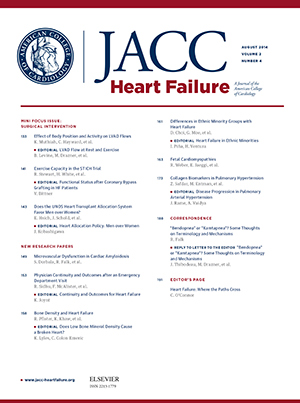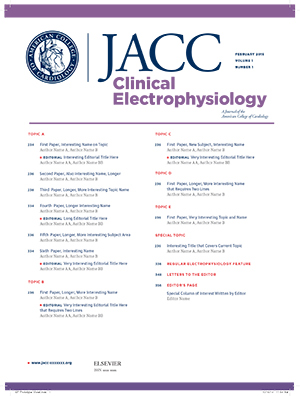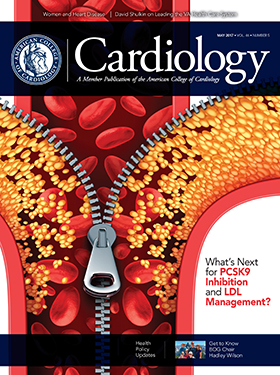JACC: Heart Failure
Does Exercise Lower the Risk of Myocardial Damage?
 Physical activity may lower the risk of myocardial damage in middle-aged and older adults and reduce the levels of myocardial damage in people who are obese, according to a study published April 24 in JACC: Heart Failure. Physical activity may lower the risk of myocardial damage in middle-aged and older adults and reduce the levels of myocardial damage in people who are obese, according to a study published April 24 in JACC: Heart Failure.
Roberta Florido, MD, and colleagues examined 9,427 patients aged 45-64 years without cardiovascular disease and a body mass index of more than 18.5 kg/m2. Physical activity was measured through a questionnaire and categorized according to current guidelines as “recommended” (at least 75 minutes per week of vigorous intensity or at least 150 minutes per week of a combination of moderate to vigorous intensity), “intermediate” (1-74 minutes per week of vigorous intensity or 1-149 minutes of a combination of moderate to vigorous intensity), or “poor” (no moderate to vigorous exercise). To measure myocardial damage, researchers assessed levels of high-sensitivity troponin T (hs-cTnT).
Results showed that elevated hs-cTnT was observed in 7.2 percent of the total study population. Participants who performed poor and intermediate levels of physical activity were 39 percent and 34 percent more likely to have myocardial damage than persons who engaged in recommended levels of physical activity.
The researchers subsequently looked at the combined associations of physical activity and obesity with hs-cTnT. Participants with obesity who performed poor levels of exercise had the highest likelihood of having elevated hs-cTnT. Patients with obesity who performed recommended levels of physical activity had a weaker association with elevated hs-cTnT, and after adjustment for traditional cardiac risk factors, this association was no longer statistically significant. These results suggest physical activity may lessen the association of obesity and myocardial damage. The authors also found a significant interaction between physical activity and obesity with elevated hs-cTnT, indicating the protective association of physical activity and myocardial damage may be stronger among individuals with obesity, a group at particularly high risk for future heart failure.
In an accompanying editorial, Tariq Ahmad, MD, MPH, FACC, and Jeffrey M. Testani, MD, MTR, encourage cardiologists to promote healthy habits rather than simply treating heart failure after it has developed. “What if we started to view heart failure as a failure, of not only of the heart to keep up with the metabolic demands of the body, but also the community of cardiologists to promote the behaviors that lead to its development?” they ask. “This will surely encourage a shift beyond the reactionary approaches used in contemporary clinical practice and force us into interactions with the multitude of stakeholders that play a role in improving the cardiovascular health of our communities.”
Florido R, Ndumele CE, Kwak L, et al. JACC: Heart Fail 2017;5:377-84.
|
JACC
The Burden of CVD in the Aging Population
 Cardiovascular disease presents a great burden for the elderly population, their caregivers and the health system, according to a state-of-the-art review published April 10 in the Journal of the American College of Cardiology. Cardiovascular disease presents a great burden for the elderly population, their caregivers and the health system, according to a state-of-the-art review published April 10 in the Journal of the American College of Cardiology.
Francesco Paneni, MD, PhD, et al., examine unresolved clinical problems in the care of elderly patients, summarize the current understanding of the mechanisms implicated in cardiovascular aging, consider the potential of targeting novel pathways and review the critical aspects of vascular repair.
Among the clinical aspects of cardiovascular disease in elderly patients is systolic hypertension, which, paired with its accompanying fall in diastolic pressure, can hasten the development of myocardial ischemia. Although the medical community currently lacks sufficient understanding of the primary age-related triggers for the patho-physiological processes that contribute to cardiovascular complications in the aging population, the review notes that some interventions have been shown to improve outcomes in patients with isolated systolic hypertension.
Heart failure with preserved ejection fraction (HFpEF) is common in elderly patients, especially women. Clinicians often point to the increasing prevalence of HFpEF and its adverse outcomes in the aging patient population; however, so far there have been few evidence-based interventions to halt the development or effects of HFpEF. Vascular aging and amyloidosis, along with frailty and loss of muscle mass and function, also contribute to the increased risk of cardiovascular disease in the aging population.
The review also examines the molecular hallmarks of cardiovascular aging. Strategies are emerging that target reactive oxygen species (ROS) and have yielded encouraging preclinical results. Other promising efforts include the development of anti-inflammatory agents that might reduce cardiovascular disease and new molecular targets that are involved in essential pathways regulating ROS production and/or scavenging and pro-inflammatory cytokines.
“These more targeted and selective interventions merit attention, given the disappointments encountered with the application of blunt approaches to limiting oxidative stress in humans,” said Paneni. He adds that lifestyle changes such as caloric restriction or regular endurance exercise may reduce signs of vascular aging.
The authors conclude that “translation of the basic and clinical science reviewed here should prepare us better to confront the burden of cardiovascular disease in our growing older population.”
Paneni F, Cañestro DC, Libby P, et al. J Am Coll Cardiol 2017;69:1952-67.
|
JACC
Review Looks at State Requirements For AEDs in Schools
 The installation of automatic external defibrillators (AEDs) in schools is associated with increased survival after sudden cardiac arrest (SCA), according to a review published March 27 in the Journal of the American College of Cardiology. The installation of automatic external defibrillators (AEDs) in schools is associated with increased survival after sudden cardiac arrest (SCA), according to a review published March 27 in the Journal of the American College of Cardiology.
As state requirements for AEDs in schools in the U.S. vary widely, Mark V. Sherrid, MD, FACC, et al., used LexisNexis Academic to identify all current state statutes and regulations pertaining to AEDs in schools.
They found that only 17 of 50 U.S. states had some legislation requiring AED installation in schools, but the remaining 33 states had no legislation. In states with legislation requiring AED installation, requirements were far from comprehensive, with only five states offering unequivocal funding to schools for purchasing AEDs. Researchers calculated that nearly 35 million public elementary and secondary students in the U.S. attend a school with no legislative requirement for a school AED.
They explain that the principal obstacle of installing AEDs in schools is cost, which can be substantial, particularly in states with many schools. However, the estimated $3,300 cost of two AEDs and training for each school is small when compared with the overall expenditure per student in U.S. elementary and high schools, which averaged $11,000 - $12,000 in 2010.
The researchers also note that a questionnaire study of SCA in U.S. high schools determined that two in 50 U.S. high schools can expect an SCA event each year. Several observational studies showed an association between AED installation in schools and colleges with increased survival. Collapse to defibrillation time was shorter when administered by bystanders than by Emergency Medical Services (3.3 vs. 12.9 minutes). In schools with AED programs, the survival rates of students with cardiac arrests and a shockable rhythm ranged from 64 to 72 percent.
The authors conclude that timely AED availability is important in all population-dense settings, and an AED requirement in schools should be added in these states as part of a policy to expand the reach of public access defibrillation community wide.
“This review should be used to inform the debate about expanding community-access AEDs into schools,” says Sherrid.
Sherrid MF, Aagaard P, Serrato S, et al. J Am Coll Cardiol 2017;69:1735-43.
|
JACC: Clinical Electrophysiology
NCDR Study Finds Dual-Coil ICDs More Common Than Single-Coil ICDs
 Despite a recent decrease in use, dual-coil implantable cardioverter-defibrillators (ICDs) continue to represent the majority of implants in the U.S. and outnumber single-coil ICDs, according to a study published April 26 in JACC: Clinical Electrophysiology. Despite a recent decrease in use, dual-coil implantable cardioverter-defibrillators (ICDs) continue to represent the majority of implants in the U.S. and outnumber single-coil ICDs, according to a study published April 26 in JACC: Clinical Electrophysiology.
Sean D. Pokorney, MD, MBA, et al., used ACC’s ICD Registry to analyze 435,772 patients across 1,690 hospitals who had an ICD implanted between April 2010 and December 2015. Results showed that while the use of dual-coil ICDs decreased from 86 percent to 55 percent within the five-year study period, the authors found that 72 percent of the total patient population received a dual-coil ICD.
They also classified the hospitals into three groups based on the frequency of the dual-coil ICD (low, decreasing and high). They found that hospitals in the low-use group were more likely to have ICDs implanted by electrophysiologists and more likely to perform extractions compared with high-use groups (90 percent vs. 46 percent; median 7 vs. median 2, p < 0.001).
The study authors highlight that certain patients at higher risk of arrhythmia (who are obese, African-American, have end-stage kidney disease and more) might benefit from dual-coil ICDs, however, patients’ risk levels were not the deciding factor. “The data show that hospital-level factors are driving decision-making around ICDs instead of being more patient-focused,” Pokorney states.
The authors conclude that moving forward, future research on ICDs should examine whether the decreasing trend in dual-coil ICDs can be associated with improved patient outcomes.
In a related editorial, Fred Kusumoto, MD, FACC, explains that “[a]lthough the study by Pokorney et al. does not supply any additional clinical insight into the relative merits of single- or dual-coil lead designs, it does provide fascinating insight into how changes in clinical practice occur in real life, particularly within a specialized field such as electrophysiology.” He adds that, “the electrophysiology social network is well connected, and best practices in our field will continue to spread rapidly, generally without the requirement for active intervention programs. However, we must continue to be willing to share, to be open to change, and to develop new ties.”
Pokorney SD, Parzynski CS, Daubert JP, et al. JACC: Clin Electrophysiol 2017; April 26:[Epub ahead of print].
|
|
 Read the full May 2017 issue of Cardiology at ACC.org/Cardiology
Read the full May 2017 issue of Cardiology at ACC.org/Cardiology
 Physical activity may lower the risk of myocardial damage in middle-aged and older adults and reduce the levels of myocardial damage in people who are obese, according to a study published April 24 in JACC: Heart Failure.
Physical activity may lower the risk of myocardial damage in middle-aged and older adults and reduce the levels of myocardial damage in people who are obese, according to a study published April 24 in JACC: Heart Failure.
 Cardiovascular disease presents a great burden for the elderly population, their caregivers and the health system, according to a state-of-the-art review published April 10 in the Journal of the American College of Cardiology.
Cardiovascular disease presents a great burden for the elderly population, their caregivers and the health system, according to a state-of-the-art review published April 10 in the Journal of the American College of Cardiology.

 Despite a recent decrease in use, dual-coil implantable cardioverter-defibrillators (ICDs) continue to represent the majority of implants in the U.S. and outnumber single-coil ICDs, according to a study published April 26 in JACC: Clinical Electrophysiology.
Despite a recent decrease in use, dual-coil implantable cardioverter-defibrillators (ICDs) continue to represent the majority of implants in the U.S. and outnumber single-coil ICDs, according to a study published April 26 in JACC: Clinical Electrophysiology.